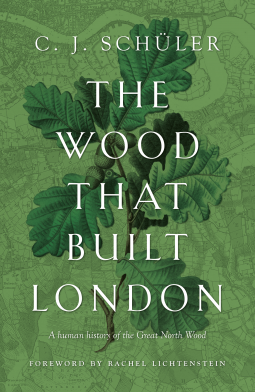
The Wood That Built London
A Human History of the Great North Wood
by C. J. Schüler
This title was previously available on NetGalley and is now archived.
Send NetGalley books directly to your Kindle or Kindle app
1
To read on a Kindle or Kindle app, please add kindle@netgalley.com as an approved email address to receive files in your Amazon account. Click here for step-by-step instructions.
2
Also find your Kindle email address within your Amazon account, and enter it here.
Pub Date 7 Oct 2021 | Archive Date 15 Oct 2021
Talking about this book? Use #TheWoodThatBuiltLondon #NetGalley. More hashtag tips!
Description
It is hard to imagine that the busy townscape of South London was once a great wood, stretching almost seven miles from Croydon to Deptford or that, scattered through the suburbs, from Dulwich to Norwood, a number of oak woodlands have survived since before the Norman Conquest.
These woods were intensively managed for a thousand years, providing timber for construction, furniture and shipbuilding, and charcoal for London’s blacksmiths, kilns and bakeries. Now they afford important green space, a vital habitat for small mammals, birds and insects. Drawing on a wealth of documents, historic maps and environmental evidence, The Wood That Built London charts the fortunes of the North Wood from its earliest times: its ecology, ownership, management, and the gradual encroachment of the metropolis.
A Note From the Publisher
Plate section not included in this epub.
Advance Praise
‘Deeply rewarding’ Paul Wood, author of London’s Street Trees
‘Timely and informative’ Travis Elborough, author of A Walk In the Park
‘Deeply rewarding’ Paul Wood, author of London’s Street Trees
‘Timely and informative’ Travis Elborough, author of A Walk In the Park
Available Editions
| ISBN | 9781913207496 |
| PRICE | £19.99 (GBP) |
Links
Average rating from 3 members
Featured Reviews
Well, that's good timing; there hasn't been a full history of the Great North Wood in 120 years, but I've only been here five and along one comes. Turns out that, like so much in British life which seems immemorial, the name is not as old as all that; it's not found before 1863, and then with a lower case 'g' - that's in the proceedings of the Surrey Archaeological Society, and it's clear throughout that Schüler has done an impressive job of digging through all manner of journals, surveys (once charmingly called 'terriers'), court records &c going right back to the Middle Ages. But whereas some historians who have the research down can end up producing dry works, better referenced than read, Schüler has also managed to build his findings into something a general reader can enjoy – albeit, it must be admitted, perhaps more readily if they regularly spend time within the Wood's old precincts. Which are wider than you might think; I'm lucky enough to live between some of the more impressive surviving stands (it was an almost numinous joy to learn from this book that one of the weeds in my back garden is considered an ancient woodland indicator), but until the 18th century the trees ran from Croydon to the Thames. Not that they were still truly wild then; they haven't been for at least a thousand years, and probably more. There's an undercurrent running through the book in which Schüler picks up, gently, the recent findings about symbiosis in woodlands, and sets that against the human relationship with woodlands as it used to be, where we were also part of a grand system. I don't mean that in some dippy hippy sense, but as a simple matter of husbandry: as Schüler quotes Oliver Rackham saying, "a wood need no more be destroyed by felling than a meadow is destroyed by cutting a crop of hay". A long-standing process of rotation and replenishment which fell apart as capitalism started getting its claws in, culminating in the 19th century with a tension between clear-felling for short term gain on one side, and new appreciation of woods as imagined idyll on the other. Although of course there were further wrinkles within that; the survival of one hefty chunk, now Grangewood Park, is down to its time as the private estate of industrialist Charles Hood.
Given the scale of the wood that was, as against the fragmentary survivals, there are inevitably times when the book makes for a painful read. I was particularly appalled by the Tudor Vermin Acts, offering tuppence per otter or hedgehog killed, and a penny per wildcat – even for something as beautiful as the kingfisher, their extirpation was incentivised. The problem with hedgehogs, incidentally, was that they were believed to suck the milk from sleeping cows – thank goodness we no longer destroy blameless animals because of a debatable impact on bovine health, eh, readers? And as Schüler notes, modern agriculture and habitat loss has done far more damage than these laws ever could, not least because inflation meant the rewards didn't long justify determined anti-otter warfare. But that habitat loss still feels a lot like the Biblically mandated clearing of 'wastes' which segued so smoothly into capitalism's inability to value anything without a financial benefit evident in the most reductive terms. "When human society was made up of small communities separated by wide expanses of untamed land, our settlements mere pinpricks of light in the vast darkness of the pre-industrial night, the biblical injunction made sense; since then, however, we have gone on multiplying and subduing and exercising dominion to the point where the Earth may never recover." And even now, when we're supposed to know a little better, the green rhetoric often falls apart as soon as a council sees an opportunity to make a few quid, or one local Hyacinth Bucket complains that a freshly laid hedge is 'untidy'. The destruction may sometimes be greenwashed with talk of offset or mitigation but, as Schüler points out, when it comes to ancient woodland this can only ever be a sham and a sop. Just when my ire at the destructive nonsense of HS2 had been dying down, an' all.
Still, if the story is in many respects a tragic one, it does have a fine cast. Schüler is particularly keen to note people who, inspired by the Great North Wood, have gone on to have a wider impact on life sciences or the preservation of nature, such as John Ray (1628-1705), first to formulate the concept of species, or the Norwood vicar who sent an 1885 letter requesting preservation of the woods to Reginald Brabazon – who four years later would make the first proposal for a London green belt. Elsewhere, it's just fun to see celebrity connections; I hadn't realised that Sir Thomas Wyatt had estates where now sits Loughborough Junction, or that Byron visited the wood's Gypsies – who, like its sometime reputation for lawlessness, get less space here than I expected. Although I was amused to learn that the stretch of road where I catch the bus was once known as Leather Bottle Lane, presumably for an association with bootlegging. Similarly, it was good to learn that the road where my usual supermarket sits, and the meadow nearby, are named for Walter Whitehorse, shieldbearer to Edward III and the first known Black Rod. Doesn't Whitehorse, Black Rod sound like an obscene* riff on Short Skirt, Long Jacket? Surely the most exciting cameo, though, at least if you watch Upstart Crow, is Robert Greene, whose Quip For An Upstart Courtier had a local reference: "Marry, quoth her that lookt like Lucifer, though I am black, I am not the Divell, but indeed a collyer of Croydon". Obviously I can only hear this delivered in Mark Heap's voice, to pained silence.
As we approach the present, some of the later chapters can get a little bogged down. The same punctilious digging in the records which earlier impressed becomes more tiring when you're dealing with recent council meetings and their more complete records, though heavens know if someone could have done the same centuries ago then it would have been enormously useful now, so it can hardly be denied that this too is in the historian's remit. The penultimate chapter is more a guide to the wood as it currently stands, right down to recommended bus routes; certainly a useful thing to have, but perhaps one which might have made more sense as an appendix, particularly given the vertigo occasioned when the final chapter flips back from visitor recommendations to the grim prospects for nature generally, and thus humanity also, in the coming years. Though after that there is a glossary too, including one lovely term I didn't know, marcescence - "the retention of dead, dry leaves by a tree during winter". Feels uncomfortably reminiscent of the remaining traces of life in 21st century Britain, doesn't it?
*Conversely, the true meaning of Penge is here, and turns out only to be rude if you squint, which is a bit of a shame.
(Netgalley ARC, lacking the plates – and I imagine they'll make for an even better reading experience)
Readers who liked this book also liked:
Sophie Campbell
Comics & Graphic Novels, Entertainment & Pop Culture, Sci Fi & Fantasy
Antony Johnston
General Fiction (Adult), Mystery & Thrillers, New Adult

















